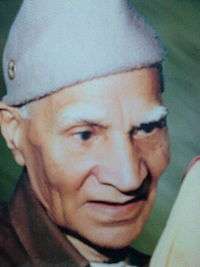Bhagat Munshi Ram
| Bhagat Munshi Ram | |
|---|---|
|
Bhagat Munshi Ram | |
| Born | Sialkot, Punjab |
| Died | India, Chandigarh |
| Nationality | Indian |
| Other names | Sant Satguru Bhagat Ji Maharaj, Bhagat Ji |
Bhagat Munshi Ram (19 December 1906 – 29 June 1998)[1][2] was born in the village Sundernagar, tehsil and district Sialkot, Punjab (now in Pakistan) in the year 1906.[3] He was assigned specific work of Guru in the year 1977 by putting a religious mark on the forehead, presenting 'turban' (Hindi:पगड़ी), Rs.5 and a coconut by Param Dayal Baba Faqir Chand ji Maharaj. Initially, reluctant Bhagat returned the turban to Faqir but accepted it back when Faqir insisted. On understanding the last will of Faqir and the scenario after Faqir's death, he preferred to leave Manavta Mandir in the year 1982.[4][5][6][7] He performed specific duties of Satguru (in terms of the last will of Faqir Chand.[8][9][10][11][12] Bhagat Munshi Ram wrote flag song of Religion of Humanity established by Baba Faqir Chand. He also wrote prayer of humanity sung in school run by Manavta Mandir, Hoshiarpur. Both were introduced by Faqir himself.[13] Bhagat identified Satsang, Satnam and Satguru as one concept that is true 'experienced knowledge' (Hindi:सत्ज्ञान) imparted by living guru. This concept had been mystified by many gurus resulting in exploitation of poor people.[14]
A follower and interpreter of Faqir's opinion
Bhagat Munshi Ram wrote first interpretation of Baba Faqir Chand's last will in accordance with Faqir's life and work. It was published in the year 2007. Bhagat further developed and explained various aspects of Faqir's new approach to higher stages of self realization or Surat Shabd Yoga. His published discourses and works depict utility and positive aspects of Indian saintism. He also explored its weaknesses and internal contradictions with a special mention of prophesies made by them which ultimately turned out to be false. He had explored Religion of Humanity through the mission of Data Dayal:'Be man, entire, whole and in everything' wherein a 'human being'becomes 'international center' of Religion of Humanity. Verses written by Bhagat are brief history of Faqir's mission and work. The content underlines importance of commitment to Guru's teachings in totality, the best kind of love in Sant Mat. Bhagat has interpreted 'Dayal Faqir Mat' (Faqir's opinion). His published books are:-
1.Sant Satguru Waqt Ka Vasiyatnama (The Last Will of Sant Satguru Waqt)[15] 2. Satguru Ki Mahima Aur Maya Ka Roop (The Glory of Satguru and Form of Maya[16] 3. Sant Mat (Dayal Faqir Mat Ki Vyakhya) (The Opinion of the Saints:The opinion of Dayal Faqir)[17] 4.Antarrashtriya Manavta Kendra (International Center of Humanity)[18] 5.Prem Shabdavali[19]
He has written 'Megh-Mala' a book completely dedicated to Megh people of India and the teaching of Baba Faqir Chand.[20] His work includes a book on untouchability, a social evil of Indian society representing caste prejudice.[21]
See also
External links
- http://sites.google.com/site/munshirambhagat/
- http://www.babafaqirchand.com/baba.html
- https://www.flickr.com/photos/100gurus/4589771306/
References
- ↑ http://bhagatshaadi.com/megh/Sant%20Satguru%20Vaqt%20Ka%20Vasiyatnama.pdf. Sant Satguru Waqt Ka Vasiyatnama, Bhagat Munshi Ram, pp.3, Retrieved on 2009-10-21
- ↑ Bhagat Munshi Ram (2007). Sant Satguru Waqt Ka Vasiyatnama (in Hindi). Kashyap Publication. p. Last page, Introduction of writer. ISBN 978-81-905501-1-6.
- ↑ http://bhagatshaadi.com/megh/MEGH-MALA.pdf. p.17, Retrieved on 2009-10-18
- ↑ http://bhagatshaadi.com/megh/Sant%20Satguru%20Vaqt%20Ka%20Vasiyatnama.pdf. Sant Satguru Waqt Ka Vasiyatnama, Bhagat Munshi Ram, p.57, Retrieved on 2009-10-16
- ↑ Bhagat Munshi Ram (2007). Sant Satguru Waqt Ka Vasiyatnama (in Hindi). p. 150. ISBN 978-81-905501-1-6.
- ↑ books.google.co.in, Retrieved on 2009-10-16. |Google Books
- ↑ http://dlane5.tripod.com/guru1.html. David C. Lane, tripod.com.
- ↑ http://bhagatshaadi.com/megh/Sant%20Satguru%20Vaqt%20Ka%20Vasiyatnama.pdf.%5B%5D, Sant Satguru Waqt Ka Vasiyatnama, Bhagat Munshi Ram, p.48, Retrieved on 2009-10-16
- ↑ Bhagat Munshi Ram (2007). Sant Satguru Waqt Ka Vasiyatnama (in Hindi). p. 131. ISBN 978-81-905501-1-6.
- ↑ http://bhagatshaadi.com/megh/Sant%20Satguru%20Vaqt%20Ka%20Vasiyatnama.pdf. Sant Satguru Waqt Ka Vasiyatnama, Bhagat Munshi Ram, p.11, Retrieved on 2009-10-16
- ↑ Bhagat Munshi Ram (2007). Sant Satguru Waqt Ka Vasiyatnama (in Hindi). pp. 29–31. ISBN 978-81-905501-1-6.
- ↑ Bhagat Munshi Ram (2007). Satguru Ki Mahima Aur Maya Ka Roop (in Hindi). p. 53. ISBN 978-81-905501-0-9.
- ↑ Bhagat Munshi Ram (2009). Prem Shabdavali (in Hindi). pp. 41–44 and 64–65. ISBN 978-81-905501-9-2.
- ↑ Bhagat Munshi Ram (2008). Sant Mat (Dayal Faqir Mat Ki Vyakhya). Kashyap Publication. p. 40. ISBN 978-81-905501-4-7.
- ↑ Bhagat Munshi Ram (2007). Sant Satguru Waqt Ka Vasiyatnama (in Hindi). ISBN 978-81-905501-1-6.
- ↑ Bhagat Munshi Ram (2007). Satguru Ki Mahima Aur Maya Ka Roop (in Hindi). ISBN 978-81-905501-0-9.
- ↑ Bhagat Munshi Ram (2008). Sant Mat (Dayal Faqir Mat Ki Vyakhya) (in Hindi). ISBN 978-81-905501-4-7.
- ↑ Bhagat Munshi Ram (2009). Antarrashtriya Manavta Kendra (in Hindi). ISBN 978-81-905501-6-1.
- ↑ Bhagat Munshi Ram (2009). Sant Satguru Waqt Ka Vasiyatnama (in Hindi). ISBN 978-81-905501-9-2.
- ↑ Bhagat Munshi Ram. "Megh Mala". Google sites. Retrieved 2010-05-13.
- ↑ Bhagat Munshi Ram. "Chhuachhut Kab aur Kyon". Google site. Retrieved 2010-05-13.
